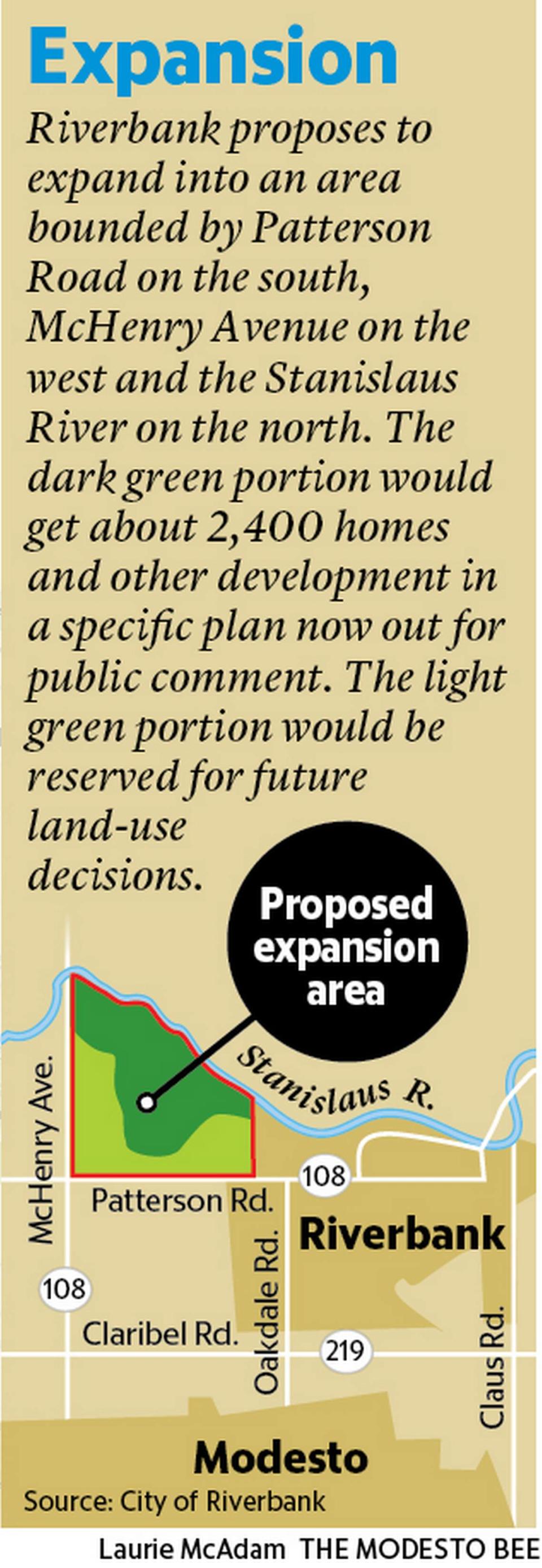Ballot measure seeks to stop 2,400-home project that would expand Riverbank to McHenry
Opponents have launched a ballot measure against a 2,400-home project that would greatly expand Riverbank to the west.
The River Walk development also would bring businesses and parks to 993 acres that are now mostly farmland. It would cover about two-thirds of a proposed annexation stretching west to McHenry Avenue, north to the Stanislaus River and south to Patterson Road.
The measure would require voter approval of River Walk and most other future projects west of the current Riverbank city limit. That line is about halfway between Coffee and Oakdale roads.
A local group called Voters for Farmland filed the paperwork allowing signature-gathering to start Friday, June 23. Under state law, it needs at least 10% of the registered voters in Riverbank over 180 days.
River Walk critics have said this land is a key part of the region’s food industry and especially well-suited to recharging groundwater during storms.
“It’s some of the best — if not the best — farmland and permeable soils we have in the Valley,” co-organizer Denny Jackman said in a phone interview Monday. He is a former Modesto councilman long involved in farmland preservation.
Riverbank voters could see the measure on the November 2024 ballot, unless the City Council declares a special election earlier. Supporters first need to collect at least 1,280 valid signatures.
Mayor Richard O’Brien said by email Tuesday that he does not yet have a position on River Walk, including whether it would burden city services.
“As for the urban growth boundary initiative, I believe in property rights for landowners,” he added. “An urban growth boundary being imposed against the wishes of the property owners would violate their property rights.”
Councilwoman Rachel Hernandez emailed that she has no opinion yet on either River Walk or the ballot measure. Councilman Luis Uribe declined to comment. Members Darlene Barber-Martinez and Leanne Jones Cruz did not respond to email inquiries as of Wednesday morning.
A representative of the developers also could not be reached. The land has several owners who farm nuts, fruits and other crops. They propose mostly low-density housing, along with areas of medium and high-density homes, some of them a short walk to businesses.
River Walk process began two years ago
River Walk was announced in June 2021, when the city staff began the environmental review process. It was expected to result in the 2022 release of a draft report on impacts to farmland, roads, water supplies, wildlife and other concerns. That document is still not out.
The release will kick off a period for public comment, followed by revision of the report to address the concerns. The project would then go before the Riverbank Planning Commission, which would make a recommendation to the City Council.
The last step would be the Stanislaus County Local Agency Formation Commission. It rules on annexations to cities, including effects on farmland.
The ballot initiative would apply to westward annexations not approved by LAFCO as of July 1 of this year. River Walk conceivably could make it through that stage in the next year or so, only to become subject to a vote of the electorate following the measure’s approval.
It would exempt projects in support of agriculture, such as farmworker housing. It also would allow construction of other homes aimed at meeting California’s mandate for affordable housing, if state officials sign off on each project.
River Walk would increase the number of homes in Riverbank by about 30%. The city now has about 25,000 residents.
The annexation would include not just the 993 acres for River Walk but an additional 529 just to the south. Development decisions would be deferred to an unknown time for this portion, which has long frontages on McHenry Avenue and Patterson Road. A 150-acre solar plant is in the southwest corner.
Development would include homes for people of all ages
River Walk was outlined in a virtual public presentation by consultant Steve McMurtry two years ago. He said it would offer a mix of housing densities suited to young families, seniors and other residents. He is a principal planner for De Novo Planning Group, based in El Dorado Hills.
The plan includes:
1,550 low-density homes, up to eight per acre, on a total of 366 acres
702 medium-density homes, up to 16 per acre, on a total of 54 acres
180 high-density homes, averaging 18 per acre, on a total of 10 acres
71 acres of “mixed use,” including retail, services and housing close to one another
60 acres of open space along the bluff overlooking the river, which would have habitat protections and trails
44 acres of parkland in other spots.
Part of River Walk would be for residents 55 and older. They could find services close by and drive electric golf carts charged on site, McMurtry said.
Other places to build homes in Riverbank
Farmland advocates see the River Walk area as a key buffer between Riverbank and north Modesto. They say Riverbank still has plenty of vacant home sites from past annexations. They are mainly near the current eastern boundaries. Most of the current home-building is in a new phase of the Crossroads area.
Riverbank has a modest amount of downtown housing, which could grow under a plan approved in 2015. At the district’s west edge is a former cannery where a walkable mix of homes and businesses was envisioned. The city has since leased the site to a cannabis company over 20 years.
River Walk opponents have spoken at numerous city and LAFCO meetings over the past year. The matter has not been on any agendas, so officials could not respond in detail.
Hernandez, who is also vice mayor, said she will consider these comments and other information as River Walk advances.
“I am keeping an open line of communication so that I can make the most informed decision,” she said.



